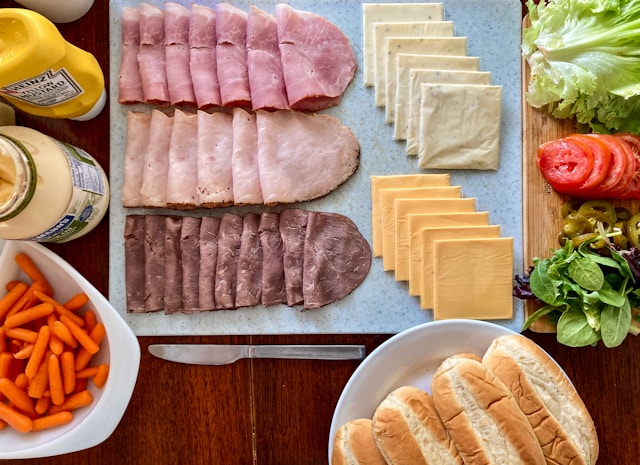For a slice of Americana, a few sandwiches rival the iconic hoagie. This hearty creation balances meat, cheeses, and toppings inside a crusty hoagie roll, evolving from a Philadelphia deli favorite to a national gas station staple. Let’s explore how this beloved sandwich traveled from local delicacies to road trip essentials, cementing its place in American hearts and stomachs.
Already hungry? Join our hoagie hunter adventure with SIXT. Grab the opportunity as our hoagie hunter, to help us uncover what makes the perfect hoagie. Our Hoagie hunter will gather data on over 100 gas station hoagies across America; and win $2,500 and a $500 gas station gift card.
What is a Hoagie?

A traditional Italian hoagie is made with a long Italian roll, filled with ingredients such as:
- Italian meats, such as salami, capicola, or prosciutto.
- Provolone cheese
- Lettuce
- Tomatoes
- Onions
- Oil and vinegar dressing
- Optional hot or sweet peppers
Each ingredient is layered meticulously, creating a harmony of flavors and textures, with the hoagie roll’s slightly crusty exterior and soft interior playing a crucial role in holding everything together for an easy bite on the go.
Origins of the Hoagie
The hoagie sandwich has been a staple for generations. From humble beginnings in Philadelphia to a popular gas station and convenience store staple, the rise of the hoagie mirrors America’s evolving cuisine culture of convenience.
The term “hoagie” is thought to have originated in Philadelphia in the early 20th century, though its exact origins are disputed. One theory links the name to Italian-Americans working at the Hog Island shipyard, who packed large sandwiches for lunch called “hoggies,” which later morphed into “hoagies”.
Italian American-owned delis played a crucial role in spreading the hoagie’s popularity. Family-run, these delis offered fresh, made-to-order sandwiches that celebrated their cultural heritage. The hoagie soon became a lunchtime favorite in Philadelphia workplaces and schools, spreading slowly to surrounding regions.
In other regions, New Yorkers use “hero,” and Midwesterners refer to it as a “submarine” or “sub”. New Englanders refer to Hoagies with warm fillings as a “grinder”, while Philadelphia locals use this term for a Hoagie that is warmed as a whole. Despite the regional variations, “hoagie” remains the most iconic term, especially in Philadelphia, where it reflects Italian-American heritage.
The Gas Station Revolution
The rise of convenience stores attached to gas stations transformed the hoagie’s reach, making them a favorite for road trippers and busy professionals alike. As Americans grew more mobile and time-pressed, gas stations became one-stop shops for food and fuel. The hoagie is a deliciously filling meal that can be eaten on the go, with the potential for customization, making them an ideal fit for this change in American lifestyles.
For many Americans, gas station hoagies have become a cultural touchstone. Whether it’s a quick lunch on a busy workday or a much-needed road trip snack, hoagies from gas stations offer an accessible, satisfying option. The sheer number of gas stations across the country means a good hoagie is never too far, whether in a bustling city or a remote highway stop.
The Wawa Effect
Wawa, a Pennsylvania-based chain, revolutionized the gas station hoagie. Known for its made-to-order sandwiches and touch-screen ordering system, Wawa standardized the gas station hoagie experience with consistent quality and variety. Its influence pushed competitors to improve their food offerings, raising the bar for convenience store sandwiches across the country. Though certainly a popular choice for travelers, whether these sandwiches are hoagies could be a subject of debate, due to their isolation from the Italian-American family-run origins.
The Modern Hoagie: Gourmet Evolution

Today’s gas station hoagies are more sophisticated than their predecessors. Many locations now offer gourmet versions with:
- Artisanal hoagie breads and rolls
- Vegetarian and vegan options
- Premium, locally sourced meats and cheeses
- Unique flavor combinations
These improvements reflect broader trends in American food culture, where consumers are demanding higher-quality ingredients and more diverse choices, even at convenience stores.
Artisanal hoagie shops have also sprung up, focusing on diverse ingredients, creative combinations, and locally sourced products. These gourmet shops push the boundaries of what a hoagie can be, catering to food enthusiasts who seek a more upscale sandwich experience.
Hoagie Tourism
For food lovers, seeking out the best hoagies has become a form of culinary tourism. Travelers visit iconic hoagie spots across the country, sampling regional variations. Some key destinations include:
- Philadelphia’s Reading Terminal Market, for traditional Italian hoagies.
- New Orleans, for the muffuletta (a close cousin of the hoagie).
- Chicago, for the Italian beef sandwich.
- New England, for their distinctive “grinders”
These regional variations showcase the versatility of the hoagie concept, with each area adding its particular flair to the classic sandwich.
The Future of Hoagies
Looking ahead, the hoagie continues to evolve alongside consumer preferences. Current trends shaping the hoagie landscape include:
- Incorporating international flavors, such as Mediterranean or Asian-inspired ingredients
- Offering healthier options, including whole grain hoagie breads and leaner proteins
- Focusing on sustainable and eco-friendly packaging
One notable shift in the hoagie’s future could be tied to the rise of electric vehicles (EVs). As more Americans adopt EVs, which require longer charging times, gas stations and convenience stores may transform their food offerings. With people spending more time at charging stations, these locations may cater to the demand for more elaborate, higher-quality food and drink choices, potentially elevating the gas station hoagie experience.
From its humble origins in Philadelphia’s Italian-American neighborhoods to its status as a gas station staple, the hoagie is a true American success story. Its evolution reflects changing consumer preferences and the rise of convenience-driven food culture. Yet, despite these changes, the hoagie remains beloved for its satisfying, versatile nature. Whether you’re grabbing a hoagie at a roadside gas station or visiting a high-end deli, the sandwich remains a timeless and essential part of American cuisine. Try pairing them with a variety of road trip snacks and drinks to create the perfect on-the-go meal! As food trends shift and technology changes how and where we eat, the hoagie will continue to adapt—but its place in the pantheon of American sandwiches is secure. Next time you fill up at the gas station, take a moment to appreciate the rich history behind your hoagie. It’s more than just a sandwich—it’s a slice of Americana.